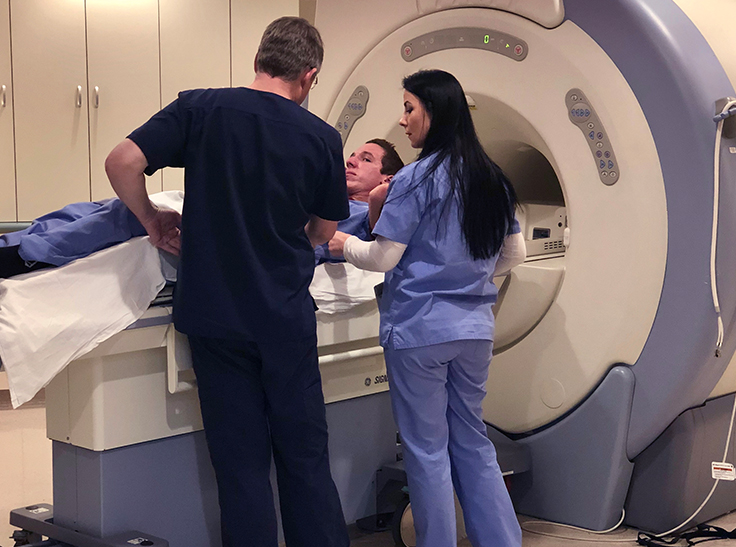INTERESTED IN LEARNING MORE?
REQUEST INFOINTERESTED IN LEARNING MORE?
REQUEST INFOThe advent of diagnostic medical imaging has given us an important tool when it comes to preventing, diagnosing, and treating medical conditions and diseases. It’s given us a way to look inside patients’ bodies and monitor their health without the need for invasive procedures like exploratory surgery. You can be a part of this fast-growing, in-demand career field with the Academic Associate of Science in Magnetic Resonance Imaging from Smith Chason College’s WCUI School of Medical Imaging.
Of the different types of medical imaging out there, one of the most dynamic and capable is magnetic resonance imaging, or MRI. MRI machines use magnetic fields and radio waves to produce detailed images of the inner workings of your body. When an X-ray or ultrasound can’t provide a complete picture, doctors and physicians turn to MRIs in order to discover the root of a health issue. In particular, ultrasounds can’t look through bones or gas, so MRIs might be necessary to see through concealed areas of the body to what’s going on beneath. MRIs can be ordered for any part of the body, and teams of medical professionals then use those images and results to come to a diagnosis and a preferred method of treatment. It is a tool that can result in life-saving medical decisions.
An MRI technologist is trained to perform a number of different tasks and responsibilities, which might vary depending on the setting in which you’re working and the types of patients you interact with. It might include:
For those who are interested in a career as an MRI technologist, the first step is to enroll in a quality, hands-on education program that can provide the education you need. The MRI associate degree program at WCUI is an ARRT-approved program that can help prepare you for an entry-level career in this specialized medical field by teaching you how to use this dynamic technology to help diagnose and monitor diseases. We focus on the courses and technical skills that you need on the job, with additional preparation for registration and certification exams.
MRI technologists should also have:
See our Pathways to Registry for Academic Associate of Science in Magnetic Resonance Imaging to see the registry exams* you’re eligible to take and which exam fees are included in the program cost.
* These registries are independent organizations and the prerequisites for eligibility can change at any time without WCUI’s knowledge or consent. This document is meant to be a guide only and all students should review the registry’s website for the most up-to-date information.
While the certification requirements for MRI technologists vary from state to state, most employers are looking for candidates who have passed their certification exams, even if it isn’t a state requirement. WCUI strongly recommends obtaining certifications to provide you with the best knowledge and opportunities when entering the sonography field. WCUI provides registry reviews and assistance with the registry exam process. See our Pathways to Registry for information on which exam fees are included in the WCUI program cost.
At WCUI, our associate degree in MRI uses a combination of teaching methods and techniques, including online classes, in-person lectures, hands-on education in lab settings, and externship experience. The Magnetic Resonance Imaging program includes coursework on:
Our mission and values at WCUI are about promoting the academic excellence and integrity of our graduates in a way that is supportive and contributes positively to our students’ lives. We are here for you, to get you the healthcare education you need for success.
Our MRI associate degree program features both lecture-based courses and lab work in:

The population of the U.S. is aging and significantly increasing the rates of things like cancer and Alzheimer’s disease, which is increasing the demand for diagnostic and preventative medical services, like MRIs. Preventative and diagnostic services like MRIs will see the demand go up significantly, adding thousands of jobs to the field through 2030.
*State of California EDD https://www.labormarketinfo.edd.ca.gov/data/employment-projections.html “Projected growth” represents the estimated change in total employment over the projections period (2018-2028).
**Arizona Commerce Authority https://www.azcommerce.com/oeo/labor-market/employment-projections/ “Projected growth” represents the estimated change in total employment over the projections period (2020-2030)
A little over half of the 42,000 MRI technologists employed across the U.S. in May of 2020 were at state, local, and private hospitals, including academic and research hospitals and specialty hospitals.
The rest of the techs were employed at the wide variety of other medical facilities that are in need of trained MRI operators, including:
WCUI’s Academic Associate of Science in Magnetic Resonance Imaging program can be completed in as few as 18-21* months, and students become eligible for relevant ARRT and ARMRIT registry exams upon graduation.
*An optional 18-month program is only available at our California campuses.
In response to COVID-19, WCUI has moved to a hybrid educational model so your education doesn’t miss a beat. Our program combines online lecture classes with in-person ultrasound labs and 6-months of externship at a hospital or clinical site.
WCUI was founded by well-respected medical professionals, and we’ve been using our experience and knowledge to help our students begin successful careers for over 20 years. We’ve been accredited by the Accrediting Commission of Career Schools and College as a private post-secondary vocational school since 2001.
Are you ready to advance your career by advancing your education? Find the information you need to apply to the WCUI School of Medical Imaging on our Admissions Page or contact our admissions team today.
ENROLLING NOW! Now enrolling for Spring Term starting April 1